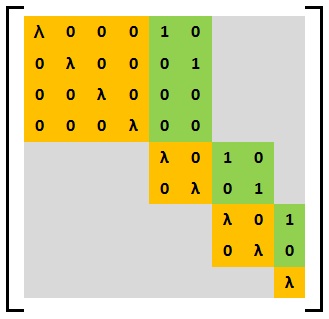Reduction to the nilpotent case
Let  be a square matrix of order
be a square matrix of order  over an algebraically closed field and let the distinct eigenvalues of
over an algebraically closed field and let the distinct eigenvalues of  be
be  . The Jordan–Chevalley decomposition theorem states that
. The Jordan–Chevalley decomposition theorem states that  is similar to a block diagonal matrix of the form
is similar to a block diagonal matrix of the form

where  is a diagonal matrix,
is a diagonal matrix,  is a nilpotent matrix, and
is a nilpotent matrix, and  , justifying the reduction of
, justifying the reduction of  into subblocks
into subblocks  . So the problem of reducing
. So the problem of reducing  to the Weyr form reduces to the problem of reducing the nilpotent matrices
to the Weyr form reduces to the problem of reducing the nilpotent matrices  to the Weyr form. This leads to the generalized eigenspace decomposition theorem.
to the Weyr form. This leads to the generalized eigenspace decomposition theorem.
Given a nilpotent square matrix  of order
of order  over an algebraically closed field
over an algebraically closed field  , the following algorithm produces an invertible matrix
, the following algorithm produces an invertible matrix  and a Weyr matrix
and a Weyr matrix  such that
such that  .
.
Step 1
Let 
Step 2
- Compute a basis for the null space of
 .
. - Extend the basis for the null space of
 to a basis for the
to a basis for the  -dimensional vector space
-dimensional vector space  .
. - Form the matrix
 consisting of these basis vectors.
consisting of these basis vectors. - Compute
 .
.  is a square matrix of size
is a square matrix of size  − nullity
− nullity  .
.
Step 3
If  is nonzero, repeat Step 2 on
is nonzero, repeat Step 2 on  .
.
- Compute a basis for the null space of
 .
. - Extend the basis for the null space of
 to a basis for the vector space having dimension
to a basis for the vector space having dimension  − nullity
− nullity  .
. - Form the matrix
 consisting of these basis vectors.
consisting of these basis vectors. - Compute
 .
.  is a square matrix of size
is a square matrix of size  − nullity
− nullity  − nullity
− nullity .
.
Step 4
Continue the processes of Steps 1 and 2 to obtain increasingly smaller square matrices  and associated invertible matrices
and associated invertible matrices  until the first zero matrix
until the first zero matrix  is obtained.
is obtained.
Step 5
The Weyr structure of  is
is  where
where  = nullity
= nullity .
.
Step 6
- Compute the matrix
 (here the
(here the  's are appropriately sized identity matrices).
's are appropriately sized identity matrices). - Compute
 .
.  is a matrix of the following form:
is a matrix of the following form:
 .
.
Step 7
Use elementary row operations to find an invertible matrix  of appropriate size such that the product
of appropriate size such that the product  is a matrix of the form
is a matrix of the form  .
.
Step 8
Set  diag
diag  and compute
and compute  . In this matrix, the
. In this matrix, the  -block is
-block is  .
.
Step 9
Find a matrix  formed as a product of elementary matrices such that
formed as a product of elementary matrices such that  is a matrix in which all the blocks above the block
is a matrix in which all the blocks above the block  contain only
contain only  's.
's.
Step 10
Repeat Steps 8 and 9 on column  converting
converting  -block to
-block to  via conjugation by some invertible matrix
via conjugation by some invertible matrix  . Use this block to clear out the blocks above, via conjugation by a product
. Use this block to clear out the blocks above, via conjugation by a product  of elementary matrices.
of elementary matrices.
Step 11
Repeat these processes on  columns, using conjugations by
columns, using conjugations by  . The resulting matrix
. The resulting matrix  is now in Weyr form.
is now in Weyr form.
Step 12
Let  . Then
. Then  .
.























































































